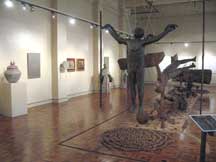Beloved Land

The National Museum visual arts collection is organized according to phrases taken from the National Anthem.
This room introduces the scope of the history of art in the Philippines through a timeline. Together with this timeline are works that explain how the National Art Gallery is designed in terms of concepts and ideas. For instance, how it tries to reveal shifts and continuities in visual culture, or the culture of seeing and making reality visible in visual form.
A prominent piece is Roberto Feleo’s Tau Tao(1994) that evokes the Bagobo myth of the afterlife; it is an example of contemporary art but at the same time leads us to the deep past of our ancestors.
Placed around this work are various objects that are related to each other, with the hope that their relationships will prompt us to consider certain breaks and connections. For instance, a secondary burial artifact like the Manunggul Jar tells the story of an afterlife, which is told differently by a depiction of the Holy Trinity. There are also fine examples of contemporary art from the North and the South of the Philippines, attesting to the vibrant tradition of the visual arts in the country.

You will notice that the Gallery relates paintings and sculptures that are considered art by society with other things that are produced within the same society. This is done to situate art in the context of an extensive material culture and to encourage us to ask questions about what is art, how is it different from other things, and so on.
A museum collects, conserves, researches, communicates, and exhibits for the appreciation of the public the material evidence of a people and their environment.
Art is part of this evidence that is mingled or mixed with other pieces of evidence. The National Art Gallery belongs to the larger institution of the National Museum and art is part of a wider world of the practice of creation and expression.


